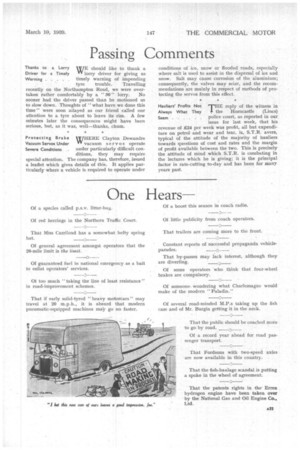Passing Comments
Page 33

If you've noticed an error in this article please click here to report it so we can fix it.
Thanks to a. Lorry WE should like to thank a Driver for a Timely VY lorry driver for giving us
Warning timely warning of impending tyre trouble. Travelling recently on the Northampton Road, we were over taken rather comfortably by a " 30" lorry. No sooner had the driver passed than he motioned us to slow down. Thoughts of " what have we done this time" were soon allayed as our friend called our attention to a tyre about to leave its rim. A few minutes later the consequences might have been serious, but, as it was, well—thanks. chum.
WHERE Clayton Dewandre
vacuum servos operate under particularly difficult conditions, they may require special attention. The company has, therefore, issued a leaflet which gives details of this. It applies particularly where a vehicle is required to operate under
Protecting Brake Vacuum Servos Under Severe Conditions .
conditions of ice, snow or flooded roads, especially where salt is used to assist in the dispersal of ice and snow. Salt may cause corrosion of the aluminium; consequently, the valves may seize, and the recommendations are mainly in respect of methods of protecting the servos from this effect.
Hauliers' Profits Not THE reply of the witness in Always What They I the Horncastle (Lincs)
Seem police court, as reported in our
issue for last week, that his revenue of £24 per week was profit, all but expenditure on petrol and wear and tear, is, S.T.R. avers, typical of the attitude of the majority of hauliers towards questions of cost and rates and the margin of profit available between the two. This is precisely the attitude of mind which S.T.R. is combating in the lectures which he is giving; it is the principal factor in rate-cutting to-day and has been for many years past.




























































































